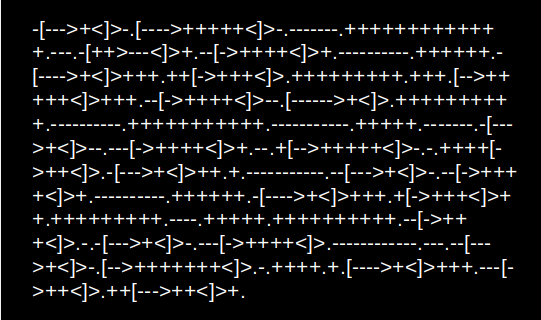
Esoteric or esoteric programming languages are a rarity in the computer world. They were not created for software production in the traditional sense, but rather as experiments or challenges to test the limits of programming. We will tell you about the fascinating universe of esoteric programming languages (also known as "Esolangs") that defy conventional logic and offer a unique insight into the creativity and idiosyncrasies of programmers.
Esolangs are distinguished by several salient features that separate them from conventional programming languages. First, they are often deliberately cryptic, meaning that they are designed to be difficult to read and write intuitively. This is achieved through the use of unconventional commands, unusual symbols, and puzzling grammar rules. In addition, the Esolangs often lack practical utility and instead focus on artistic expression, experimentation, and abstract problem solving. These languages are often Turing complete, meaning that they can perform any computation that any other language can do, but do so in such unusual and complex ways that they defy the limits of conventional understanding. Finally, Esolangs encourage creativity and out-of-the-box thinking, making them fertile ground for programmers seeking intellectual challenges and artistic expression rather than practical applications.
What are the four fundamental elements that make up a programming language?
- Assignment: a value is assigned to a variable or constant.
- Statement: a variable or function is created.
- Operation: a data is modified by arithmetic, transformation or logical operations.
- Selection: the sequence is divided according to a logical condition.
Why use esoteric languages?
Although these languages are rarely applied in practical projects, they have an undeniable appeal. First, Esolangs provide a platform for creativity and innovative thinking. Programmers often use them as a means to challenge themselves and explore unique solutions to abstract problems. In addition, esoteric languages can be a source of fun and entertainment, as their quirky nature and unconventional rules often generate comical results. Some even use them for artistic purposes, creating unique works of programming that defy expectations. In short, esoteric languages, while not suitable for hands-on programming, offer a unique venue for experimentation, expression and intellectual satisfaction for those programmers seeking a different approach to the world of coding.
To take into account when creating an esoteric program
Start by clearly defining the purpose of your esoteric language. What will make it unique or interesting? Decide if you want it to be humorous, challenging, absurd, or have some other distinguishing feature. We recommend you follow these steps:
- Design Syntax: Design the syntax of the language. Decide what types of commands or instructions will be used and how statements will be structured in the program.
- Choose an Implementation: Decide how you will implement the language. You can choose to create an interpreter or a compiler for your language, depending on your knowledge and goals.
- Write the Specification: Clearly document the syntax and behavior of your language in a detailed specification. This will help other programmers understand and use your language.
- Interpreter/Compiler coding: Implement your language interpreter or compiler according to the specification. This will require writing code in an existing programming language.
- Testing and Debugging: Perform extensive testing to ensure that your language works as intended. Identify and fix bugs in the implementation.
- Create Examples and Documentation: Create examples of programs in your language and provide documentation explaining how to use it and what can be achieved with it.
- Sharing and Collaboration: Share your language with the programming community on specialized forums and websites. Accept feedback and contributions from other programmers to improve and expand your language.
Some esoteric programming languages

The first esoteric programming language, known as "Brainfuck"was created by programmer Urban Müller in 1993. Brainfuck is famous for being one of the most minimalistic and cryptic programming languages ever conceived. It has only eight commands, which makes programming in Brainfuck an intriguing challenge. Although it is not designed to be practical or useful in real-world applications, Brainfuck has gained notoriety in the programming community because of its extreme simplicity and its ability to inspire creativity in problem solving. Urban Müller created Brainfuck as an experiment to demonstrate that it is possible to create an extremely simple programming language that is still Turing complete, meaning that it can perform any computation that any other programming language can do. Since then, Brainfuck has inspired the creation of many other esoteric programming languages with equally peculiar and challenging approaches.
Among the diversity of esoteric programming languages, other notable examples include:
- Malbolge: Malbolge is known to be one of the most incomprehensible programming languages ever created. It was designed to be as difficult as possible to understand and program, which makes it a real intellectual challenge.
- Whitespace: Unlike most languages, Whitespace uses only whitespace, tabs and line breaks for programming. Whitespace programming is based on the amount and formatting of whitespace, resulting in seemingly blank programs.
- INTERCAL: INTERCAL mocks programming conventions with chaotic syntax and absurd commands. Its design is a satire of traditional programming and focuses on the frustration of the programmer.
Limitations and challenges of esoteric programming languages
Despite their unique appeal, esoteric programming languages also present notable challenges and limitations. One of the main challenges lies in their lack of practical applicability. These languages, designed to be cryptic and quirky, are not suitable for real software development, which limits their usefulness in most cases. In addition, the learning curve is often extremely steep, and programming in an esoteric language can require disproportionate effort compared to more conventional languages. In addition, the scarcity of widely available resources and documentation can make it difficult to understand and learn these languages. Despite these limitations, esoteric programming languages remain a valuable niche for creative exploration and intellectual fun, attracting programmers willing to take on the challenge and explore the limits of the art of programming.
The esoteric programming languages community
Esoteric programming languages have given rise to a unique and passionate community of programmers who share a common interest in exploring the unusual and the creative in the coding world. This community is characterized by a willingness to share and create new languages. Esolang programmers often participate in competitions and contests dedicated to creating even stranger and more challenging programming languages. These challenges stimulate innovation and encourage creativity, resulting in the constant generation of new Esolangs. In addition, there are useful websites and resources that serve as knowledge centers for the community, providing documentation, examples and discussion forums where programmers can share ideas and collaborate on projects related to esoteric programming languages. Collectively, this active and passionate community plays a vital role in the evolution and preservation of esoteric programming languages, fostering diversity and innovation in the programming world.
- Esolang Wiki: It is a wiki that acts as an online encyclopedia that compiles detailed information about various esoteric programming languages. It provides documentation, code examples and details about the history and features of Esolangs.
- Meowlangis an esoteric programming language inspired by LOLCODE, a language created by Adam Lindsay based on Internet lolspeak.
- The Esoteric Languages Reference Manual: An online resource that provides a collection of documentation and examples of various esoteric programming languages, making it easy to explore and understand these unconventional languages.
- The subreddit r/esolangs: Reddit has an active community of esoteric language programmers in the r/esolangs subreddit. Here, enthusiasts can discuss projects, share code and explore new languages.
- Esolang Discord Servers: There are several Discord servers dedicated to the discussion of esoteric programming languages. These servers provide a platform for real-time communication and collaboration between programmers.
- Esoteric Competitions and Contests: Events such as "The Underhanded C Contest". y "The International Obfuscated C Code Contest"are examples of competitions where programmers compete to create unusual and challenging programs in esoteric programming languages.
Esoteric programming languages may seem strange and puzzling, but they represent a fascinating underworld of creativity and challenge for programming enthusiasts. Although you are unlikely to write useful applications in Esolangs, exploring their unusual syntax and solving puzzles is a unique way to exercise your mind and expand your understanding of programming. This handbook will serve as an introductory guide to delve into this unconventional world and discover the hidden gems of esoteric programming languages.






